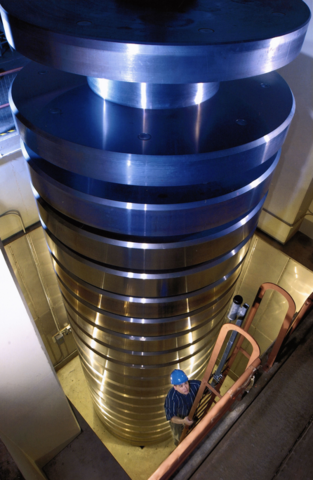How Do You Measure the Thrust of a Rocket Engine?

Rockets that launch into space have to be able to push a lot of weight. They have to overcome the relentless pull of gravity while carrying themselves and their payloads into orbit or beyond. Researchers who design rocket engines need to be able to test them, without actually launching the rockets, to make sure that they are producing enough thrust to accomplish their task.

So how do they test them? Quite simply, they turn the rocket engine on its side and attach its body to a large immovable stand to hold it in place. Arrayed in key places around the stand are devices called load cells. As the rocket engine burns through its fuel, it creates a force in the opposite direction of the thrust. This force pushes against the load cells, which compress like springs to measure that force and give a readout.
These load cells have many different designs, but they are all pretty much based on the same simple idea: They contain devices known as strain gauges that are bonded to metal. The strain gauges convert mechanical forces on the load cell into an electrical signal.
When an engine is being tested, it exerts forces on the metal in the load cell. When a metal is being pulled apart, it becomes more resistive to the flow of electricity, and when it’s being compressed, it becomes less resistive. In either case, this changes the electrical voltage of a circuit in the load cell. The strain gauge can measure with high accuracy the changes in electrical voltage and use this knowledge to determine the amount of force being put on the load cell.
But how do you know the load cells are accurate? Even though the load cells’ properties have been well measured before their first use, these devices still need to be periodically calibrated to ensure that they are functioning properly and giving the right readings. To do that, you need known weights that you can put on the scale, i.e., the load cell. But where do you get weights big enough to calibrate something meant to measure the thrust of a rocket engine? Not many places. One place that does have such weights is the National Institute of Standards and Technology (NIST) and its 4.45 meganewton (1 million pounds force) deadweight machine in Gaithersburg, Maryland.
Built in 1965, the deadweight machine consists of a stack of 20 stainless steel discs about 3 meters (a little less than 10 feet) in diameter that sit in its weight pit, spanning about 10 meters (about 35 feet) in height when assembled. Their average mass is about 22,696 kg (just over 50,000 pounds) each. The weights are picked up in a chainlike fashion using a hydraulic jack to create pushing and pulling forces.
Using this titanic machine, NIST calibrates load cells for customers who in turn use them to measure large forces like those produced by rockets and jet engines. Because NIST is the national measurement institute of the United States and responsible for making sure that measurements accurately trace back to the International System of Units (also known as the SI, or metric system), our customers know that the calibrations they are getting are meticulously accurate, ensuring that their instruments are giving them correct measurements and giving them confidence they can reach for the stars.

